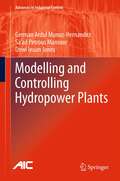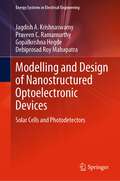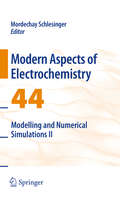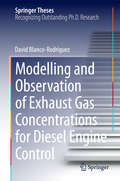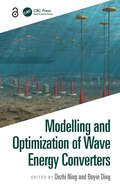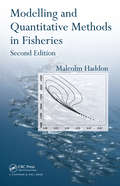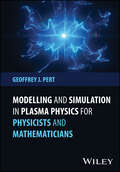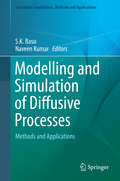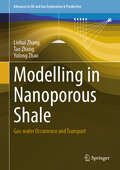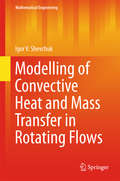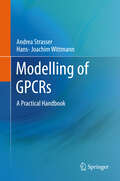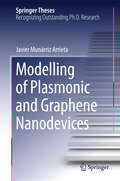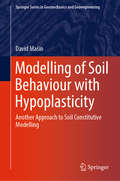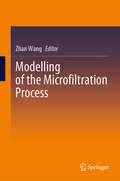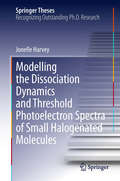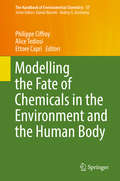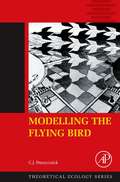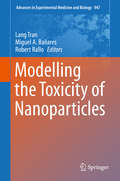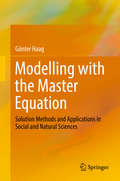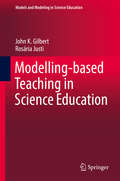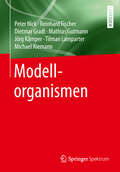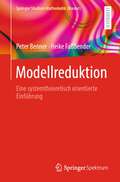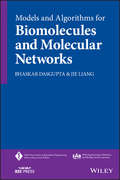- Table View
- List View
Modelling and Controlling Hydropower Plants
by Sa'Ad Petrous Mansoor German Ardul Munoz-Hernandez Dewi Ieuan JonesHydroelectric power stations are a major source of electricity around the world; understanding their dynamics is crucial to achieving good performance. The electrical power generated is normally controlled by individual feedback loops on each unit. The reference input to the power loop is the grid frequency deviation from its set point, thus structuring an external frequency control loop. The book discusses practical and well-documented cases of modelling and controlling hydropower stations, focused on a pumped storage scheme based in Dinorwig, North Wales. These accounts are valuable to specialist control engineers who are working in this industry. In addition, the theoretical treatment of modern and classic controllers will be useful for graduate and final year undergraduate engineering students. This book reviews SISO and MIMO models, which cover the linear and nonlinear characteristics of pumped storage hydroelectric power stations. The most important dynamic features are discussed. The verification of these models by hardware in the loop simulation is described. To show how the performance of a pumped storage hydroelectric power station can be improved, classical and modern controllers are applied to simulated models of Dinorwig power plant, that include PID, Fuzzy approximation, Feed-Forward and Model Based Predictive Control with linear and hybrid prediction models.
Modelling and Design of Nanostructured Optoelectronic Devices: Solar Cells and Photodetectors (Energy Systems in Electrical Engineering)
by Jagdish A. Krishnaswamy Praveen C. Ramamurthy Gopalkrishna Hegde Debiprosad Roy MahapatraThis book approaches the design of functionally superior optoelectronic devices through the use of bio-inspired nanostructures and multiscale material structures through a step-by-step approach. The book combines both the fundamental theoretical concepts involved in understanding and numerically modelling optoelectronic devices and the application of such methods in addressing challenging research problems in nanostructured optoelectronic design and fabrication. The book offers comprehensive content in optoelectronic materials and engineering and can be used as a reference material by researchers in nanostructured optoelectronic design.
Modelling and Numerical Simulations II
by Mordechay SchlesingerThis volume is meant as an introductory resource aimed at practitioners of electrochemistry research, technology, and development mainly at the atomic, molecular or macromolecular levels. Thus emphasis is placed at length scales in the 1-100 nm range. The volume will help provide understanding of electrochemical phenomena and materials at the nanoscale through modeling and numeric simulations. It also serves as a means to create and use structures, electrochemically based devices, and systems that possess novel properties and functions because of their small or intermediate sizes.
Modelling and Observation of Exhaust Gas Concentrations for Diesel Engine Control
by Dr Ing. David Blanco-RodriguezThe book presents a complete new methodology for the on-board measurements and modeling of gas concentrations in turbocharged diesel engines. It provides the readers with a comprehensive review of the state-of-art in NOx and lambda estimation and describes new important achievements accomplished by the author. These include: the online characterization of lambda and NOx sensors; the development of control-oriented models of lambda and NOx emissions; the design of computationally efficient updating algorithms; and, finally, the application and evaluation of the methods on-board. Because of its technically oriented approach and innovative findings on both control-oriented algorithms and virtual sensing and observation, this book offers a practice-oriented guide for students, researchers and professionals working in the field of control and information engineering.
Modelling and Optimization of Wave Energy Converters
by Dezhi Ning Boyin DingWave energy offers a promising renewable energy source. This guide presents numerical modelling and optimisation methods for the development of wave energy converter technologies, from principles to applications. It covers oscillating water column technologies, theoretical wave power absorption, heaving point absorbers in single and multi-mode degrees of freedom, and the relatively hitherto unexplored topic of wave energy harvesting farms. It can be used as a specialist student textbook as well as a reference book for the design of wave energy harvesting systems, across a broad range of disciplines, including renewable energy, marine engineering, infrastructure engineering, hydrodynamics, ocean science, and mechatronics engineering. The Open Access version of this book, available at https://www.routledge.com/ has been made available under a Creative Commons Attribution-Non Commercial-No Derivatives 4.0 license.
Modelling and Quantitative Methods in Fisheries
by Malcolm HaddonWith numerous real-world examples, Modelling and Quantitative Methods in Fisheries, Second Edition provides an introduction to the analytical methods used by fisheries' scientists and ecologists. By following the examples using Excel, readers see the nuts and bolts of how the methods work and better understand the underlying principles. Excel workb
Modelling and Simulation in Plasma Physics for Physicists and Mathematicians
by Geoffrey J. PertUnveiling the Secrets of Plasma Physics: A Practical Guide to Computational Simulations Plasma physics focuses on the most abundant state of matter in the universe, corresponding to ionized gas comprising ions and electrons. It can be created artificially and has a huge range of technological applications, from television displays to fusion energy research. Every application of plasma technology requires its own numerical solution to the complex physical and mathematical equations which govern the research field of plasma physics. Modelling and Simulation in Plasma Physics for Physicists and Mathematics offers an introduction to the principles of simulating plasma physics applications. It provides knowledge not only of the fundamental algorithms in computational fluid mechanics, but also their specific role in a plasma physics context. In addition, the book dissects the challenges and advancements, unveiling the delicate balance between accuracy and computational cost. Modelling and Simulation in Plasma Physics for Physicists and Mathematics readers will also find: Cutting-edge computational insights where powerful simulations meet theoretical complexities, providing physicists and mathematicians a gateway to cutting-edge research. An overview of programming language-agnostic code generation and the construction of adaptable models that resonate with the intricate dynamics of plasma physics, ensuring precision in every simulation. Advanced simplification strategies, including time splitting, analytic models, averaged rates, and tabular material, offering scientists and engineers a roadmap to balance computational demands with scientific rigor. Modelling and Simulation in Plasma Physics for Physicists and Mathematics is ideal for plasma physicists, students, and engineers looking to work with plasma technologies.
Modelling and Simulation of Diffusive Processes
by Naveen Kumar S. K. BasuThis book addresses the key issues in the modeling and simulation of diffusive processes from a wide spectrum of different applications across a broad range of disciplines. Features: discusses diffusion and molecular transport in living cells and suspended sediment in open channels; examines the modeling of peristaltic transport of nanofluids, and isotachophoretic separation of ionic samples in microfluidics; reviews thermal characterization of non-homogeneous media and scale-dependent porous dispersion resulting from velocity fluctuations; describes the modeling of nitrogen fate and transport at the sediment-water interface and groundwater flow in unconfined aquifers; investigates two-dimensional solute transport from a varying pulse type point source and futile cycles in metabolic flux modeling; studies contaminant concentration prediction along unsteady groundwater flow and modeling synovial fluid flow in human joints; explores the modeling of soil organic carbon and crop growth simulation.
Modelling in Nanoporous Shale: Gas-water Occurrence and Transport (Advances in Oil and Gas Exploration & Production)
by Tao Zhang Liehui Zhang Yulong ZhaoThis book addresses the problems involved in the modelling and simulation of shale gas reservoirs at pore scale, and details recent advances in the field. It presents the construction of simulation methods, mainly using the lattice Boltzmann method (LBM), that describe sorption, flow, and transport in nanoporous shale with some case studies. This book highlights the nanoscale effects, ascribed to the large surface-to-volume ratio, on fluids occurrence and transport physics. It discusses some interesting phenomena occurs at nanoporous shale, such as absorbed water film, water condensation, sorption hysteresis, surface excess adsorption, Knudsen diffusion, surface diffusion, structural fluid density, no-slip boundary, etc. The key techniques and methods introduced in this book provide the basis for accurate prediction of gas-well productivity. The basic principles and modeling methods are also relevant to many other nanoporous applications in science and engineering. The book aims to provide a valuable reference resource for researchers and professional scientists and engineers working on shale gas development and nanoporous media research.
Modelling of Convective Heat and Mass Transfer in Nanofluids with and without Boiling and Condensation (Mathematical Engineering)
by Igor V. Shevchuk Andriy A. AvramenkoThis book presents step-by-step description of the use of Lie group analysis to find symmetry forms and similarity solutions for single- and two-phase laminar and turbulent flows of nanofluids. It outlines novel and unique analytical solutions validated via comparisons with experimental data. The main part of the book is devoted to analytical modeling of film condensation of still and moving vapor with nanoparticles, stable film boiling of nanofluids, instantaneous unsteady boiling and condensation of nano- and ordinary fluids and clarification and quantification of instability conditions in the vapor layer, as well as centrifugal and Dean instability in nanofluids. It was demonstrated that such complex phenomena can be successfully simulated using the proposed approaches validated via reliable experiments. The book is intended for scientists, engineers, graduate and undergraduate students specializing in the area of engineering thermodynamics, heat and mass transfer and energy systems.
Modelling of Convective Heat and Mass Transfer in Rotating Flows
by Igor V. ShevchukThis monograph presents results of the analytical and numerical modeling of convective heat and mass transfer in different rotating flows caused by (i) system rotation, (ii) swirl flows due to swirl generators, and (iii) surface curvature in turns and bends. Volume forces (i. e. centrifugal and Coriolis forces), which influence the flow pattern, emerge in all of these rotating flows. The main part of this work deals with rotating flows caused by system rotation, which includes several rotating-disk configurations and straight pipes rotating about a parallel axis. Swirl flows are studied in some of the configurations mentioned above. Curvilinear flows are investigated in different geometries of two-pass ribbed and smooth channels with 180° bends. The author demonstrates that the complex phenomena of fluid flow and convective heat transfer in rotating flows can be successfully simulated using not only the universal CFD methodology, but in certain cases by means of the integral methods, self-similar and analytical solutions. The book will be a valuable read for research experts and practitioners in the field of heat and mass transfer.
Modelling of GPCRs
by Andrea Strasser Hans-Joachim WittmannG protein coupled receptors (GPCRs) comprise an important protein family, which is involved in signal transduction in the cell. Besides that a large number of drugs, available on market, address GPCRs. For an efficient and improved development of appropriate drugs, molecular modelling of GPCRs is - in order to understand the ligand-receptor interactions and functionality of GPCRs on molecular level - an important tool. The book "Modelling of GPCRs - a practical handbook" is focussed onto a practical introduction into molecular modelling of GPCRs. This book is very useful for beginners in GPCR modelling, but also addresses the advanced GPCR modeller: On the one hand, the book introduces principles of GPCR modelling, including extensive examples. On the other hand, detailed outlooks onto advanced GPCR modelling techniques are presented. Furthermore, the book includes important data, like information about crystal structures in a summarized manner or amino acid sequences, which are essential for GPCR modelling in general. Due to an increase in efficacy and data handling most modellers use LINUX as operating system. To address this, a summary of most important LINUX commands with examples is presented within the book.
Modelling of Plasmonic and Graphene Nanodevices
by Javier Munárriz ArrietaThe thesis covers a broad range of electronic, optical and opto-electronic devices and various predicted physical effects. In particular, it examines the quantum interference transistor effect in graphene nanorings; tunable spin-filtering and spin-dependent negative differential resistance in composite heterostructures based on graphene and ferromagnetic materials; optical and novel electro-optical bistability and hysteresis in compound systems and the real-time control of radiation patterns of optical nanoantennas. The direction of the main radiation lobe of a regular plasmonic array can be changed abruptly by small variations in external control parameters. This optical effect, apart from its relevance for applications, is a revealing example of the Umklapp process and, thus, is a visual manifestation of one of the most fundamental laws of solid state physics: the conservation of the quasi-momentum to within a reciprocal lattice vector. The thesis analyzes not only results for particular device designs but also a variety of advanced numerical methods which are extended by the author and described in detail. These methods can be used as a sound starting point for further research.
Modelling of Soil Behaviour with Hypoplasticity: Another Approach to Soil Constitutive Modelling (Springer Series in Geomechanics and Geoengineering)
by David Mašín<p>This book explains the hypoplastic modelling framework. It is divided into two parts, the first of which is devoted to principles of hypoplasticity. First, the basic features of soil’s mechanical behaviour are introduced, namely non-linearity and asymptotic properties. These features are then incorporated into simple one-dimensional hypoplastic equations for compression and shear. Subsequently, a hypoplastic equivalent of the Modified Cam-Clay model is developed in 2D space using stress and strain invariants to demonstrate key similarities and differences between elasto-plastic and hypoplastic formulations. Lastly, the mathematical structure of hypoplastic models is explained by tracing their historical development, from the early trial-and-error models to more recent approaches. In turn, Part II introduces specific hypoplastic models for soils. First, two reference models for sand and clay are defined. After summarising their mathematical formulations, calibration procedures are described and discussed. Subsequently, more advanced modelling approaches are covered: the intergranular strain concept incorporating the effects of small strain stiffness and cyclic loading, viscohypoplasticity for predicting rate effects, soil structure to represent structured and bonded materials and soil anisotropy. The book concludes with a description of partial saturation and thermal effects: topics that are increasingly important to the disciplines of energy and environmental geotechnics. <p>Selecting a constitutive model and its parameters is often the most important and yet challenging part of any numerical analysis in geotechnical engineering. Hypoplasticity involves a specific class of soil constitutive models, which are described in detail here. The book offers an essential resource, both for model users who need a more advanced model for their geotechnical calculations and are mainly interested in parameter calibration procedures, and for model developers who are seeking a comprehensive understanding of the mathematical structure of hypoplasticity.</p>
Modelling of the Microfiltration Process
by Zhan WangThis book presents the editor's recently proposed mathematical models for flux prediction in membrane filtration. It also provides typical mathematical models used in the development of membrane fouling control and explains the step-by-step derivation of these models. The book then highlights how these mathematical models provide insights into the mechanisms of membrane fouling and cleaning to allow for a better understanding of the complete membrane filtration process. Given its scope, this book appeals to a broad readership, particularly professionals at universities as well as engineers engaged in membrane separation in an industrial process.
Modelling the Dissociation Dynamics and Threshold Photoelectron Spectra of Small Halogenated Molecules
by Jonelle HarveyJonelle Harvey's book outlines two related experimental techniques, threshold photoelectron spectroscopy and threshold photoelectron photoion coincidence techniques, which are utilised to investigate small halogenated molecules. All the experiments were conducted at the vacuum ultraviolet beamline of the Swiss Light Source, a synchrotron photon source, which has the advantage over popular laser photon-sources of extreme ease of tunability. Three studies are presented which combine experimental and computational ab initio approaches: studying the fast dissociations of halogenated methanes in order to construct a self-consistent thermochemical network; investigating the fragmentations of fluoroethenes from timebombs, which break apart very slowly but explosively, to fast dissociators; and uncovering how vital conical interactions underpin both the results of photoelectron spectra and dissociation patterns. The details included in this thesis are useful for researchers working in the same field and those readers wishing to obtain a solid introduction into the types of systems encountered in threshold photoelectron photoion coincidence spectroscopy.
Modelling the Fate of Chemicals in the Environment and the Human Body
by Philippe Ciffroy Alice Tediosi Ettore CapriThis volume focuses on modelling the fate of chemicals in the environment and the human body to arrive at an integrated exposure assessment. It covers five broad topics, namely: future challenges in exposure assessment; the evolution of human health and environmental risk assessment; standard documentation for exposure models; modelling different environmental components (i. e. surface waters, atmosphere, soil, groundwater, plants, aquatic organisms and mammals); and the fate of contaminants in humans. This work draws on the authors' and editors' extensive experience and a range of different research activities, including case studies, that have led to the development of MERLIN-Expo, a standardised software package for simulating the fate of chemicals in the main environmental systems and in the human body in an integrated manner. It will be of considerable interest to researchers and students, risk managers, and policy- and decision-makers whose work involves environmental protection and human health.
Modelling the Flying Bird
by C. J. PennycuickThis book outlines the principles of flight, of birds in particular. It describes a way of simplifying the mechanics of flight into a practical computer program, which will predict in some detail what any bird, real or hypothetical, can and cannot do. The book and the program are based on adapting the conventional (and well-tested) thinking of aeronautical engineers to the biological problems of bird flight. Their primary aim is to convince biologists that this is the appropriate way to handle problems that involve flight, to make the engineering background accessible to biologists, and to provide a tool kit in the shape of the Flight program, which they can use to solve practical problems involving bird flight and migration. In addition, the book will be readily accessible to engineers who want to know how birds work, and should be of interest to the ever-growing community working on flapping "micro air vehicles" (MAVs). The program can be used to predict the flight performance and capabilities of reconstructed fossil birds and pterosaurs, flying in ancient atmospheres that differ from present conditions, and also, of course, to predict and account for the results of experiments and observations on living birds and bats. * An up to date work by the world's leading expert on bird flight * Examines the biology and biomechanics of bird flight with added reference to the flight of bats and pterosaurs. * Uses proven aeronautical principles to help solve biological issues in understanding and predicting the flight capabilities of birds and other vertebrates. * Provides insights into the evolution of flight and the likely capabilities of extinct birds and reptiles. * Gives a detailed explanation of the science behind, and use of, the author's predictive bird flight simulation program - Flight - which is available on a companion website. * Presents often difficult concepts in easily understood language.
Modelling the Toxicity of Nanoparticles (Advances in Experimental Medicine and Biology #947)
by Lang Tran, Miguel A. Bañares and Robert RalloIn today’s nanotechnology and pharmaceutical research, alternative toxicology testing methods are crucial for ethically and commercially sound practice. This book provides practical guidelines on how to develop and validate quantitative nanostructure-toxicity relationship (QNTR) models, which are ideal for rapidly exploring the effects of a large number of variables in complex scenarios. Through contributions by academic, industrial, and governmental experts, Modelling the Toxicity of Nanoparticles delivers clear instruction on these methods and their integration and use in risk assessment. Specific topics include the physico-chemical characteristics of engineered nanoparticles, nanoparticle interactions, in vivo nanoparticle processing, and more. A much-needed practical guide, Modelling the Toxicity of Nanoparticles is a key text for researchers as well as government and industry regulators.
Modelling with the Master Equation: Solution Methods and Applications in Social and Natural Sciences
by Günter HaagThis book presents the theory and practical applications of the Master equation approach, which provides a powerful general framework for model building in a variety of disciplines. The aim of the book is to not only highlight different mathematical solution methods, but also reveal their potential by means of practical examples.Part I of the book, which can be used as a toolbox, introduces selected statistical fundamentals and solution methods for the Master equation. In Part II and Part III, the Master equation approach is applied to important applications in the natural and social sciences.The case studies presented mainly hail from the social sciences, including urban and regional dynamics, population dynamics, dynamic decision theory, opinion formation and traffic dynamics; however, some applications from physics and chemistry are treated as well, underlining the interdisciplinary modelling potential of the Master equation approach. Drawing upon the author’s extensive teaching and research experience and consulting work, the book offers a valuable guide for researchers, graduate students and professionals alike.
Modelling, Analysis, and Control of Networked Dynamical Systems (Systems & Control: Foundations & Applications)
by Karl H. Johansson Ziyang Meng Tao YangThis monograph provides a comprehensive exploration of new tools for modelling, analysis, and control of networked dynamical systems. Expanding on the authors’ previous work, this volume highlights how local exchange of information and cooperation among neighboring agents can lead to emergent global behaviors in a given networked dynamical system.Divided into four sections, the first part of the book begins with some preliminaries and the general networked dynamical model that is used throughout the rest of the book. The second part focuses on synchronization of networked dynamical systems, synchronization with non-expansive dynamics, periodic solutions of networked dynamical systems, and modulus consensus of cooperative-antagonistic networks. In the third section, the authors solve control problems with input constraint, large delays, and heterogeneous dynamics. The final section of the book is devoted to applications, studying control problems of spacecraft formation flying, multi-robot rendezvous, and energy resource coordination of power networks.Modelling, Analysis, and Control of Networked Dynamical Systems will appeal to researchers and graduate students interested in control theory and its applications, particularly those working in networked control systems, multi-agent systems, and cyber-physical systems. This volume can also be used in advanced undergraduate and graduate courses on networked control systems and multi-agent systems.
Modelling-based Teaching in Science Education
by John K. Gilbert Rosária JustiThisbook argues that modelling should be a component of all school curricula thataspire to provide 'authentic science education for all'. The literature onmodelling is reviewed and a 'model of modelling' is proposed. The conditionsfor the successful implementation of the 'model of modelling' in classrooms areexplored and illustrated from practical experience. The roles of argumentation,visualisation, and analogical reasoning, in successful modelling-based teachingare reviewed. The contribution of such teaching to both the learning of keyscientific concepts and an understanding of the nature of science areestablished. Approaches to the design of curricula that facilitate theprogressive grasp of the knowledge and skills entailed in modelling areoutlined. Recognising that the approach will both represent a substantial changefrom the 'content-transmission' approach to science teaching and be inaccordance with current best-practice in science education, the design ofsuitable approaches to teacher education are discussed. Finally, the challengesthat modelling-based education pose to science education researchers, advancedstudents of science education and curriculum design, teacher educators, publicexaminers, and textbook designers, are all outlined.
Modellorganismen
by Peter Nick Mathias Gutmann Reinhard Fischer Dietmar Gradl Jörg Kämper Tilman Lamparter Michael RiemannDieses Buch vermittelt ein Verständnis dafür, was Modellorganismen sind, und warum sie für die Biologie eine so wichtige Rolle spielen. Im Zentrum steht, welche grundsätzlichen Ansätze mit Modellorganismen verfolgt werden und welche Limitierungen man beachten muss. Einige Modellorganismen werden exemplarisch anhand von übersichtlichen Steckbriefen vorgestellt und ihre Anwendung wird ausführlich diskutiert. Es werden außerdem wichtige wissenschaftstheoretische Grundlagen und Grundsätze der Biologie eingehend erörtert. Dieses Buch richtet sich vor allem an Studierende im fortgeschrittenen Bachelor und im Masterbereich der Lebenswissenschaften.
Modellreduktion: Eine systemtheoretisch orientierte Einführung (Springer Studium Mathematik (Master))
by Peter Benner Heike FaßbenderDieses Lehrbuch führt konsequent algorithmisch orientiert in die Modellreduktion linearer zeitinvarianter Systeme ein; der Fokus liegt hierbei auf systemtheoretischen Methoden. Insbesondere werden modales und balanciertes Abschneiden eingehend behandelt. Darüber hinaus werden Methoden des Momentenabgleichs, basierend auf Krylovraumverfahren und rationaler Interpolation, diskutiert. Dabei werden alle notwendigen Grundlagen sowohl aus der Systemtheorie als auch aus der numerischen linearen Algebra vorgestellt. Die Illustration der in diesem Buch vorgestellten Verfahren der Modellreduktion, sowie einiger der notwendigen, verwendeten Konzepte aus unterschiedlichen mathematischen Bereichen, erfolgt anhand einer Reihe von numerischen Beispielen. Dazu werden die mathematische Software MATLAB® und einige frei verfügbare Software-Pakete eingesetzt, so dass alle Beispiele nachvollzogen werden können.
Models and Algorithms for Biomolecules and Molecular Networks
by Jie Liang Bhaskar DasGuptaBy providing expositions to modeling principles, theories, computational solutions, and open problems, this reference presents a full scope on relevant biological phenomena, modeling frameworks, technical challenges, and algorithms. Up-to-date developments of structures of biomolecules, systems biology, advanced models, and algorithms. Sampling techniques for estimating evolutionary rates and generating molecular structures. Accurate computation of probability landscape of stochastic networks, solving discrete chemical master equations End-of-chapter exercises
